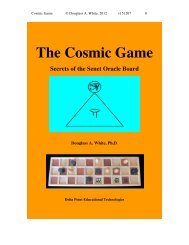You also want an ePaper? Increase the reach of your titles
YUMPU automatically turns print PDFs into web optimized ePapers that Google loves.
<strong>Cosmic</strong> <strong>Game</strong> © Douglass A. White, 2012 v151207 108<br />
According to the theory of Davidovits and Morris the Egyptians prepared the limestone<br />
blocks by breaking up weak limestone in quarries and excavation pits into rubble with<br />
their stone picks. <strong>The</strong>y then transported the rubble in baskets on donkeys. At the<br />
construction site they soaked the rubble for five to ten hours in water, during which time<br />
the weak limestone would crumble and the kaolin clay with silica and aluminum<br />
compounds would be released. <strong>The</strong>n they would add caustic soda, which they made<br />
using lime plus natron, which is mostly sodium carbonate. When the mixture set, it<br />
generated a cement or concrete that is almost exactly the same as natural limestone<br />
except that close inspection might reveal a greater jumbling than the more layered texture<br />
of usual sedimentary rock. <strong>The</strong> rock-concrete could be mixed and poured right on site<br />
and in place with a perfect fit so that no moving of heavy blocks was necessary or<br />
laborious shaping and finishing work. <strong>The</strong>y could use rammers to force the water out<br />
and simple tools to shape the material before it finally hardened.<br />
Caustic soda is sodium hydroxide (NaOH). Natron is sodium carbonate (Na2CO3), and<br />
lime is calcium hydroxide Ca(OH)2. When natron and calcium hydroxide are combined<br />
a metathesis occurs that results in the production of calcium carbonate and sodium<br />
hydroxide.<br />
Ca(OH) 2 + Na 2 CO 3 → CaCO 3 + 2 NaOH<br />
Natron in ancient Egypt was considered a sacred and divine mineral. It is well known<br />
that the Egyptians traditionally used it for preparing mummies and as an incense<br />
ingredient. What is not understood is the extent to which they used it as a special<br />
ingredient in "megalithic" construction.<br />
"Netra" or "nether" is the Egyptian word for natron and is the obvious origin of the<br />
English word. <strong>The</strong> Egyptian word derives from "neter", which is usually translated to<br />
mean divine or to indicate a deity and was written with a glyph that is a pictogram of an<br />
axe, but probably also represented a pole with a pennant on it such as they placed over<br />
the entrances to temples. "Neter" can be analyzed as "net-er", which would mean "that<br />
being which is beyond". Another analysis gives us "ne-ter", which would be something<br />
to be revered or worshipped or "for a time interval or season". English words such as<br />
nature, natal, and innate derive from "neter" via Latin.<br />
© R j ² ³<br />
neter, nejer (axe) neter (deity) netra, nether (natron) natron natron<br />
j´ ²´<br />
rincense bag sachet determinative<br />
<strong>The</strong> three dots represent powdery material, small pellets, or particles. <strong>The</strong> glyphs that<br />
surround the neter glyph represent a wall, a fort, or other edifice. <strong>The</strong>se glyphs tell us





